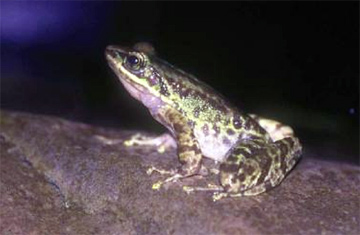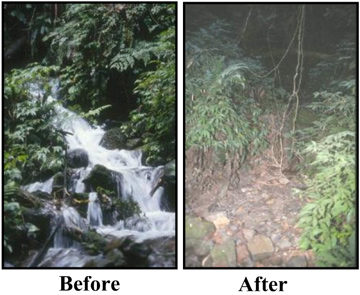Earthquake triggers decline in a frog species
Earthquake triggers decline in a frog species
Jeremy Hance, mongabay.com
December 3, 2007
Rare study of species after natural disaster provides new insights
In 1999 a 7.3 earthquake struck Nantou County at the center of quake-prone Taiwan. The earthquake caused considerable damage: over 2,000 people died and just under 45,000 houses were destroyed. It was Taiwan’s strongest quake in a hundred years. The quake also devastated a subpopulation of riparian frogs, Rana swinhoana, which had been under scientific study for three years prior. This devastation allowed scientists the opportunity to study the population changes in a species affected suddenly and irretrievably by natural disaster. Dr. Yeong-Choy Kam, one of the studies’ authors, concluded that “the most valuable part of this work is that we have provided a piece of data on effects of natural disturbance on frogs that will probably not available again.”
The IUCN lists Rana swinhoana as Least Concern, yet due to habitat loss and deforestation in Taiwan, the frog’s populations have become fragmented. The species inhabits pristine forest and displays high site-fidelity.
 Rana swinhoana. Photo by YC Lai |
The population of Rana swinhoana under study was located in the Huisun Experimental Forest. By the time scientists were able to reach the site—two months following the quake—the stream, which was the frogs’ habitat, had completely dried up, though little else was damaged. It was theorized that the earthquake had shifted underlying strata causing the water to drain out. The stream remained mostly dry for eight months; in May of 2000 water returned and stayed, only disappearing in the dry season as was typical. Still the damage was done to the frog population.
Before the earthquake, nearly 3,000 frogs were identified in numerous surveys over three years of study at the site. After the earthquake a total of 274 frogs were found in almost two years. As well, previous to the earthquake, the site had tadpoles from November to April, afterwards tadpoles could be found year-round, but at numbers 100 times less than before. From this data, it is obvious the earthquake significantly depleted the population or caused a massive migration.
 Rana swinhoana. Photo by YC Lai and YC Kam |
Scientists initially thought the latter and waited for the frogs to return to the stream, however none of the pre-earthquake frogs could be found, even after months passed. As well, all of the post-quake frogs were juveniles. Juvenile Rana swinhoana often spend much time in the surrounding forest, whereas the adult frogs are far more dependent on the streambed. It was concluded then that at the time of the earthquake the entire adult population was destroyed, leaving a small population of juveniles to recolonize the stream. This study shows that the Rana swinhoana was not able to adapt to the sudden depletion of water and thus suffered massive population loss. Dr. Kam calls this the “most intriguing part of this work the most possible explanation for the disappearance of frogs is caused by the strong site-fidelity of frogs which lacks the behavioral plasticity to such a catastrophic event.”
Dr. Kam has returned to the site twice since 2001 (when the study ended) and found that the population has not come close to regaining pre-earthquake levels, because as Dr. Kam puts it, “the hydrology of the stream has changed permanently”.
The study provided a rare opportunity to see the effect of natural disasters on a species’ population and its findings are significant for the future. With climate change happening faster than most predicted, natural disasters—flooding, drought, intense storms and change in precipitation—are believed to occur with increasing regularity. With this greater unpredictability of the climate, such studies are incredibly valuable, especially for animals like amphibians which have proven very vulnerable in the past decade. Already Dr. Kam applies this research to other incidences: “I suspect that the lack of behavioral plasticity of many riparian frogs may be able to explain why many frogs (such us golden toads) went extinct locally or regionally in a short time (say a year or two) after abnormal climatic pattern such as such drought or El Nino.” As more and more species are threatened, hopefully this study will provide insight into future occurrences, and the impetus needed to mitigate population fallouts from natural disasters.














